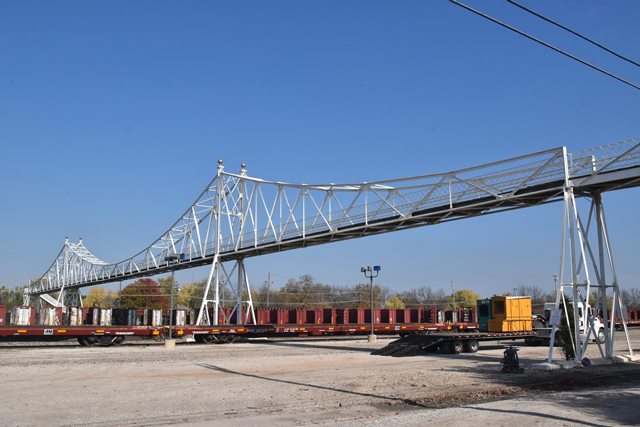We Recommend:
Bach Steel - Experts at historic truss bridge restoration.
Jefferson Avenue Footbridge

Primary Photographer(s): Nathan Holth
Bridge Documented: November 14, 2016
Springfield: Greene County, Missouri: United States
Metal Cantilever 20 Panel Rivet-Connected Warren Through Truss, Fixed and Approach Spans: Metal 3 Panel Rivet-Connected Queenpost Pony Truss, Fixed
1902 By Builder/Contractor: American Bridge Company of New York, New York and Engineer/Design: J. W. Hoover of Kansas City, Missouri
2002
175.0 Feet (53.3 Meters)
562.0 Feet (171.3 Meters)
Not Available
3 Main Span(s) and 1 Approach Span(s)
Not Applicable

View Information About HSR Ratings
Bridge Documentation
This bridge's future is at risk!
View National Register of Historic Places Nomination Form For This Bridge
This bridge is an extremely rare example of a cantilever truss footbridge. Because cantilever truss bridges were usually used for long-span crossings over large navigable rivers, they typically were not used for pedestrian-only crossings, which typically are not found on these types of crossings. However in this case, the long-span capability of the cantilever truss enables this footbridge to pass over a railroad yard without the need for many piers or bents which would obstruct the railroad. Aside from its rarity as a cantilever truss footbridge, this is a particularly old surviving cantilever truss of any type in the United States. Most date to after 1920. Lastly, this 1902 bridge, having been built by the American Bridge Company, is an early surviving bridge built under the American Bridge name, as this company had only formed a couple years earlier.
The bridge has a 175 foot main span (with the center four panels being the suspended span), with 100 foot anchor arm spans at each end, for a total cantilever truss length of 375 feet. A rare Queenpost pony truss approach span at the south end (which may not be original), and some stringer spans and stairways add to the overall length of the bridge, with an approximate total of 562 feet including stairways. The cantilever truss is unaltered and retains excellent historic integrity. The approach and stairways however have been altered from the design shown in original drawings, however the reconfigured approaches appear to have been built by simply salvaging and reusing the original approach structural steel and railing.
This bridge includes ornamental finials on the towers (main posts), and retains original lattice railing. It is an outstanding bridge and in 2002 it was rehabilitated. Interpretive signage is placed near the bridge. Nearby "Historic C-Street City Market" logos include the bridge truss in the logo. By all appearances this bridge would seem like it was preserved and appreciated. Nothing could be further from the truth, at least in city government, because the city is now planning to demolish and replace this unique bridge! This is ridiculous. The bridge was closed and fenced off a while ago after bridge inspectors found some pack rust and section loss. Actually, to be accurate, the engineering firm called the pack rust "crevice corrosion" although this term is not industry standard, and its not clear who came up with that term. Rather than propose repairs of the pack rust, and other simple repairs to maintain the bridge as-is for the long term, the city's engineering firm instead is now claiming the bridge must have a 90PSF load rating per AASHTO guidelines (please note that AASHTO guidelines are "Guidelines" and not laws or standards). This bridge does NOT need a 90PSF rating. Only extremely busy bridges such as foot bridges overlooking famous European castles, the Brooklyn Bridge in New York City, and similar bridges ever achieve the density of people required to produce 90PSF. Most people would call the police if a strange stood close enough to them to achieve a density of 90PSF. A group of concerned citizens hired another engineering firm with experience restoring historic bridges, and they proposed a much more reasonable rehab that cost less, would have lesser long-term maintenance costs, and would provide a safe load capacity for the actual levels of usage of this bridge. It remains to be seen whether the city will come to its senses and choose this rehabilitation option and retain this beautiful and iconic city landmark.
An original plan sheet from the bridge is shown below.
![]()
Photo Galleries and Videos: Jefferson Avenue Footbridge
Bridge Photo-Documentation
Original / Full Size PhotosA collection of overview and detail photos. This gallery offers photos in the highest available resolution and file size in a touch-friendly popup viewer.
Alternatively, Browse Without Using Viewer
![]()
Bridge Photo-Documentation
Mobile Optimized PhotosA collection of overview and detail photos. This gallery features data-friendly, fast-loading photos in a touch-friendly popup viewer.
Alternatively, Browse Without Using Viewer
![]()
Maps and Links: Jefferson Avenue Footbridge
Coordinates (Latitude, Longitude):
Search For Additional Bridge Listings:
Bridgehunter.com: View listed bridges within 0.5 miles (0.8 kilometers) of this bridge.
Bridgehunter.com: View listed bridges within 10 miles (16 kilometers) of this bridge.
Additional Maps:
Google Streetview (If Available)
GeoHack (Additional Links and Coordinates)
Apple Maps (Via DuckDuckGo Search)
Apple Maps (Apple devices only)
Android: Open Location In Your Map or GPS App
Flickr Gallery (Find Nearby Photos)
Wikimedia Commons (Find Nearby Photos)
Directions Via Sygic For Android
Directions Via Sygic For iOS and Android Dolphin Browser
USGS National Map (United States Only)
Historical USGS Topo Maps (United States Only)
Historic Aerials (United States Only)
CalTopo Maps (United States Only)


